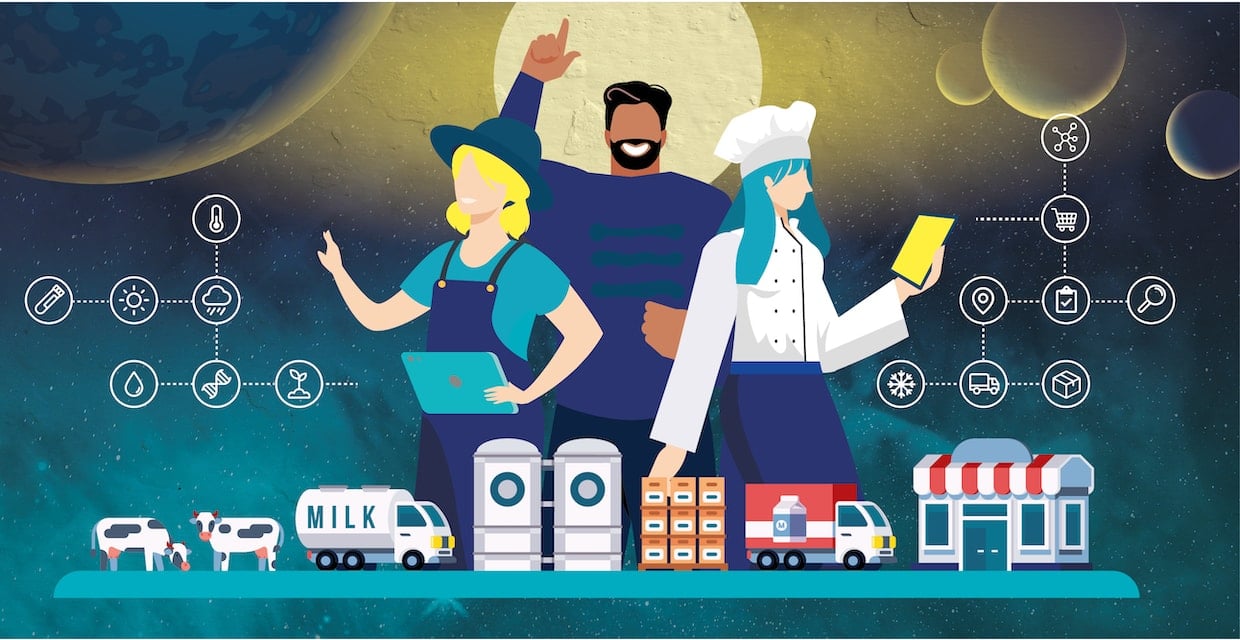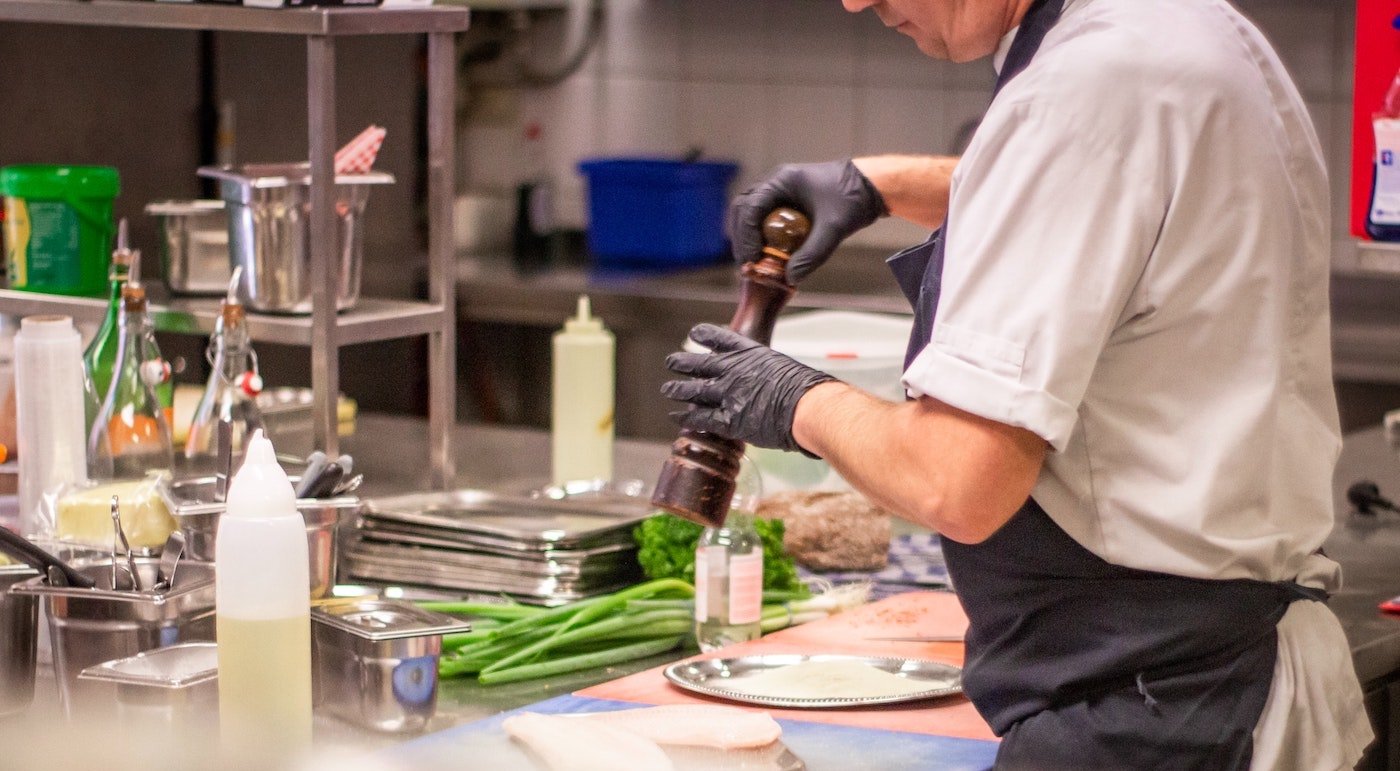SXSW 2022: Trends for the Hospitality Industry
Thomas Primus attended SXSW 2022 in the U.S. We talk to him about his impressions and what trends the event will bring for the hospitality industry.
The food supply chain comes with a number of challenges. Find out here what solutions exist and what the hospitality industry can do.

Ever since I founded FoodNotify together with my partners, one thing has been at the forefront of our minds: creating transparency along the entire food supply chain. After all, the supply chain is the hub of all processes in the food industry. In order for the value chain to function smoothly, it must be clear and consistent. Media discontinuities should therefore be largely closed in order to prevent redundancies and errors.
This can only be achieved if everyone involved plays their part and is committed to a fair, transparent and sustainable food system. The hospitality industry also plays an important role. Restaurateurs are on the one hand in contact with suppliers, and on the other hand with consumers. I have already described in a previous Utopia Gastronomica article which solutions there are for transparency along the value chain and why this is essential for hospitality businesses.
In this article, however, I am interested in exploring the complexities of the food supply chain by addressing these essential questions:
| What challenges does the food supply chain face? | |
| What can food service operators do to optimize the value chain? | |
|
What measures does the government take to improve the food system and what solutions are being proposed for the hospitality industry? |
The food supply chain is an extensive and complex process in which a large number of participants work together. It shows the path that food takes from farm to fork. The food supply chain is divided into five stages:
1. Production |
2. Handling and storage |
3. Processing and packaging |
4. Distribution and retail |
5. Consumption |
Each stage affects each other and requires valuable resources and raw materials to function. Therefore, it is even more important to streamline the entire process to avoid unnecessary costs or losses.
As technological advances transform and consumer demands and desires change, the food supply chain continues to evolve. This has led to new challenges for producers, farmers, suppliers, grocers and restaurateurs.
For example, the COVID-19 pandemic has increased consumer demand and forced restaurants to close, resulting in excess inventory for suppliers. Or processing plants had to close due to staff shortages. The result: production losses, increased costs and losses along the value chain.
Although the system has adapted to the circumstances, it has become clear what the underlying problem is – a lack of transparency. But it doesn't stop here. There are other challenges the food supply chain faces. Let's take a closer look at these.
More and more people are interested in what their food contains, where it comes from, who produces it and how fresh it is. Consumers want to be able to trace the individual steps their food takes on its way from farm to fork.
Greater transparency and improved traceability not only help consumers make informed choices about their food, but this also helps minimize the production and distribution of poor quality food.

Restaurants can meet this demand by providing their guests with useful information on food and beverages in an open and transparent manner. This includes information on allergens, nutritional values, additives, origins and carbon emissions. Digital software solutions can support you by providing this information updated in real time.
In addition, this information can also be used for marketing purposes to stand out from the competition or to create a great customer experience. For example, the German burger grill Peter Pane displays all allergens, nutritional values and additives for each recipe in its online menu, which allows the company to offer its guests added value.
In order for food suppliers and restaurateurs to provide traceability to consumers, communication between all parties in the food supply chain must be optimized. This is because there are still gaps in the food supply chain – despite the fact that technology has improved communication channels and capabilities in recent years.
Through an optimized communication process, consumers as well as manufacturers gain a comprehensive understanding of the food. Accurate, real-time documentation of the stages our food goes through also helps ensure food safety.
For food service operators, optimal communication with suppliers is critical. For this, a digital ordering platform that connects both parties is helpful, eliminating communication errors.
At this point, the concept of the digital twin should also be mentioned. In my opinion, digital twins of the purchased goods are absolutely necessary. This refers to the exact virtual model of a product or process, which can be used to make accurate predictions of how it will behave and function.
In the food service industry and hospitality sector, for example, digital twins make it possible to check the quality and freshness of products by using a wide range of data on environmental and time factors. Digital twins therefore not only increase efficiency, but also facilitate transparency enormously.
As the food supply chain evolves, there is a need for additional regulations. These are designed to ensure that all parties are treated fairly and that food is safe for consumption.
However, more regulations can lead to more challenges. For example, deliveries can be delayed because inspections include more steps and therefore take longer. Other regulations have made it harder to import goods or hire new workers. This slows down the supply chain, resulting in delivery delays and higher prices for consumers.
Stakeholders need to work together utilizing open communication and transparency to make the process more efficient and eliminate the bottlenecks caused by increased regulations.

These new challenges impact everyone in the food supply chain. To overcome them, concrete actions and goals are needed. The aim is to optimize and streamline the supply chain, creating transparency, ensuring food safety and keeping costs low.
In this context, the European Commission published a strategy in 2020 – the Farm to Fork Strategy. Its goal: to drive the transition to a fair, healthy, sustainable and environmentally friendly food system in Europe. For the first time in the EU, every single participant in the food supply chain has been considered – from production to consumption. The food service industry, with its challenges in the supply chain, is also considered individually. I will explain the solutions proposed later on.
| Ensuring sustainable food production | |
| Ensuring food security | |
| Stimulating sustainable food processing, wholesail, retail, hospitality and food service practices | |
| Promoting sustainable food consumption and facilitating the shift to healthy, sustainable diets | |
| Reducing food loss and waste | |
| Combating food fraud along the food supply chain |
To achieve these goals, a number of specific actions have been identified. For example: Revising animal welfare regulations, expanded nutrition labeling on the front of packaging, or a proposal for EU-wide food waste reduction.
As I mentioned briefly before, one goal of the Farm to Fork Strategy is to promote sustainable practices in the hospitality industry. This is because restaurateurs shape the market and influence consumers' eating habits through which suppliers they source food from, how they prepare it, and how they promote it.
But these decisions also have an impact on the environment. For this reason, it is critical for the food service industry to do its part to promote a sustainable and fair food system. The focus is on the following measures that are directly related to the hospitality and food service industry.
The Farm to Fork Strategy proposes a goal of reducing food waste by 50% by 2030 at the supplier and consumer level. In doing so, it identifies these possible solutions:
| Propose legally binding food waste reduction goals across the EU | |
| Integrate food waste prevention into other EU policies | |
| Revise EU rules on best-before dates | |
| Improve the tracking of food waste and define measures within EU member states |
While I fully support this, I believe that action against food waste is needed at all stages of the food supply chain, not just at the supplier and consumer level. After all, food waste occurs just as much during harvesting, processing, and transportation that can be avoided completely or at least in part.
In addition, food waste is a problem that also affects the hospitality industry. For this reason, solutions against food waste should be developed in this industry. For hospitality businesses, this would result in a clear advantage: by investing in the reduction of food waste, businesses could save themselves costs three times over – in purchasing, in processing and in disposing of the food. This is possible, for example, through the support of smart software solutions that address these areas.

Food packaging also plays a key role in driving the transition to a sustainable food system. The focus is on using sustainable packaging solutions made from reusable and recyclable materials. This minimizes the environmental impact caused by the high volume of production, the often short duration of use and the waste disposal problems associated with the packaging.
In this regard, since 2021 there has been an EU-wide law banning single-use plastic products for which more sustainable alternatives already exist. These include plastic straws, disposable plastic cutlery and polystyrene food containers.
To enable consumers to make informed, healthy and sustainable choices about the food they consume, food labeling is to be optimized through greater transparency. But it's not just about allergens, nutritional values and additives. Information such as the origin of products and, in the case of animal products, information on husbandry conditions and the type and origin of feed used is also important. The key to success here are modern digital systems that are connected to each other.
It is also important to define nutritional profiles, i.e. maximum levels for nutrients such as fat, sugar and salt content in food. If these are exceeded, these foods may no longer be advertised with nutritional or health claims. This is intended to make it easier to switch to a healthier diet. For example, breakfast cereals that exceed a certain sugar limit could no longer be marketed with their fiber or vitamin content.
Despite technological advances and the increasing importance of digitalization, the food supply chain is characterized by a lack of transparency. This provides some challenges, such as communication problems or lack of traceability, which also affect the hospitality industry.
In order to overcome these and therefore improve the entire value chain process, solutions need to be developed for all stakeholders. The EU has made this its goal and published the Farm to Fork Strategy. It proposes concrete actions for everyone involved in the food supply chain to promote the transition to a sustainable, healthy and fair food system.
Although this strategy is the first of its kind in the EU to look at all stages of the food supply chain, these measures alone are not enough. What is also of great importance is to create a comprehensive awareness that each individual has a responsibility to implement the strategy. All stakeholders need to be thoroughly informed and sensitized on how they can contribute to creating a sustainable food system.
Thomas Primus attended SXSW 2022 in the U.S. We talk to him about his impressions and what trends the event will bring for the hospitality industry.
Using voice control in hotels and restaurants? Read about voice technology options that already exist and what the future might look like.
The Supply Chain Act poses significant challenges for many businesses. Find out how ERP systems can streamline compliance and reduce hospitality...
Make sure you never miss out on updates and trends about digitalization in the hospitality industry by subscribing to our monthly newsletter. You will receive useful information delivered directly to your inbox.